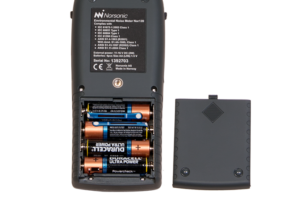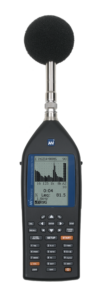Environmental Noise Meter Nor139




A general purpose class 1 sound level meter mainly designed for advanced noise assessments and noise logging,
Featuring event triggered sound recording and markers.
Overview
The Nor139 sound level meter may optionally be fitted with 1/1- and 1/3-octave filters capable of logging multispectra with a vast number of measurement parameters with a time resolution of from 100ms and on. Fitted with removable SD-card for easy to store and import measurement data to a PC.
- Environmental noise assessments
- Sound recording
- Noise source identification
- HVAC noise
- Noise hazards in the workplace
- Remote noise monitoring
- Product development
- Noise labelling
- General purpose sound level meter
- Precision integrating sound level meter to IEC 61672 class 1
- Handheld real-time 1/1-octave or 1/3-octave frequency analyser (6,3Hz-20kHz)
- Measurement of A-weighted levels simultaneously with either C- or Z-weighted levels
- Parallel detection of SPL, Leq, Lmin, Lmax, LE and Lpeak
- 120 dB dynamic range giving a “one-range” instrument
- Measures Lpeak levels up to 140 dB
- Parallel detection of F, S and I time constants
- USB 2.0 and High-speed RS-232 serial interface
- SD memory card and large high speed internal memory
- Sound recording in 8, 16 or 24 bit format with 12 or 48 kHz sampling
- Up to 90 sec. audio recording pretrigger
- High-resolution graphical backlit display
- Manual or automatic storage of results
- Automatically repeated measurements with clock synchronization
- Pause/Continue function with back erase feature
- Results displayed as dB or linear values
- Numerical printouts
- AC output signal
- Windscreen correction
- Support for IEPE sensors
- NC, NR and RC rating
- Multiple language selection
- Moving Leq
The Nor139 sound level meter may be extended with a selection of optional features that may be ordered and installed at any time.
Option packages:
All package containing the basic Nor139 with the options 1, 3, 4, 5, 6, 7, 8 and 16
Environmental package containing the basic Nor139 with the options 4, 5, 6, 7, 8 and 16.
- Parallel 1/1-octave real-time filters covering the 8 Hz – 16 kHz frequency range.
- All filters fulfil the IEC 61260 class 1 digital IIR base 10 requirements
120 dB “one-range” even in the filter bands. - Results are displayed both graphically and numerically.
- A-pre-weighting feature available on displayed results
When fitted with option 1, the Nor139 can perform real time frequency analysis in octaves covering the frequency bands 8 Hz to 16 kHz in one range. A 3 Hz 3rd order high pass filter fitted in the analogue input stage prevents overload due to low frequency noise.
- Parallel 1/3-octave real-time filters covering the 6.3 Hz – 20 kHz frequency range in one span.
- All filters fulfil the IEC 61260 class 1 digital IIR base 10 and ANSI S1.11-2004 Class 1 requirements 120 dB “one-range” even in the filter bands.
- Results are displayed both graphically and numerically.
- A-weighting (pre-weighting) feature available on displayed results.
When fitted with option 3, the Nor139 can perform real time frequency analysis in 1/3 octave covering the frequency bands 6.3 Hz to 20 kHz in one range. A 3 Hz 3rd order high pass filter fitted in the analogue input stage prevents overload due to low frequency noise.
Option 3 requires that minimum option 1 be installed.
- Calculate 7 fixed LN values (L1%, L5%, L10%, L50%, L90%, L95% and L99%).
- Parallel calculation of 1 editable LN value selectable within the range 0.1 – 99.9 %.
- Statistical calculations based on 0.2 dB class widths covering the entire 130 dB range.
- Parallel statistical calculation on both A- and C-/Z-weighted networks.
- If real-time filters are installed (option 1 or 3), statistical calculations are available for the individual filter bands as well.
Option 4 adds statistical distribution to the Nor139 functionality. There are eight percentiles shown, out of which one is user selectable. The class width is 0.2 dB over the entire 130 dB range.
The statistical distribution calculations employs the F time constant and applies to the spectral weighting networks (A and C or Z) as well as all the individual 1/1 and 1/3-octave filter bands (if applicable). The back-erase feature, which deletes up to the ten most recent seconds of acquired global data prior to a pause upon resuming, updates the statistics buffers as well to maintain consistency.
- Simultaneous measurement of F, S and I time weightings.
- Parallel measurement of three different SPL, Lmin and Lmax functions based on F, S and I time weightings.
- Parallel calculation of Leq, Leq,I, LE and LEI functions using no time constant and I time weighting simultaneously.
- The parallel measurement using three time weightings is available on both A- and C-/Z-weighted networks and the real time 1/1 and 1/3 octave filter.
- Measures the time “Profile” (level vs. time) of the noise signal with preset time resolution simultaneously with the overall “Global” measurement.
- Selection of preset intervals within the 1 second to 199 hours interval range.
- Automatic level versus time storage of LAeq, LAmax and LCpeak (or LZpeak)
Automatic multispectrum storage of Leq and Lmax if option 1 is installed. - Level versus time measurement continues during a paused Global measurement.
- Automatic markers identify any pause, stop or continue of the measurement as well as recording and overload.
- Real-time graphical and numerical display of the level versus time results.
- Selection of preset intervals within the 100 msec to 199 hours interval range.
- 25 msec interval resolution between 100 msec and one second and one second resolution above.
- Free selection of any A- and C-/Z-weighted functions to be stored at each preset interval.
- Possible operator marker settings during the measurement.
- Selection of 3 different single markers and 1 toggle marker.
The enhanced time profile mode allows logging of Leq, Lmax, Lmin, Lpeak, Le and SPL for all weighting networks and frequency bands for time constant F, S and I in parallel if option 5 parallel time constant is enabled. The user may select from one to all available parameters to log. The time resolution is from 100 ms logging to memory. If the frequency analysis option is installed, these values may be measured too, both as time profile multi spectrum values and as global values.
User controlled source coding
With option 7, the instrument gets eight marker functions, where as four are user defined. Three of these are single markers and one is a toggle marker.
Option 7 requires that minimum option 6 be installed.
- Storage of the sound signal itself onto the SD card or the internal memory.
- Triggered by an external hand-switch, by a level trigger or by a manual key push.
- 8, 16 or 24 bit accuracy.
- 12 or 48 kHz sampling.
- 0 – 96 dB digital gain.
- Reference calibration tone can be added at the beginning of the first recording in a measurement.
This option is especially useful for source identification. The sound recording can be trigged by an external hand switch, by a level trigger (requires option 16) or by a manual key push. An adjustable pretrigger records events up to 99sec before the trigger point.
Several recording formats are supported, ranging from 8, 16 or 24 bit and with sampling rates of 12 or 48 kHz. Using 48 kHz sampling and the stored sound signal may be used for further processing. The Nor139 has a large dynamic range – exceeding 120 dB. This means that if you try to play back the signal on your PC you will – in most cases – hear nothing! To overcome this problem a special digital gain, 0 – 96 dB can be added to the sound recorded signal without affecting the calibration or measured values.
Another useful feature is that you may play a 10 sec reference tone – sine wave, pink or white noise in the beginning of a measurement to set a reference level when later replaying recorded data.
Option 8 requires that minimum option 6 be installed!
- Trigger the start of a measurement based on the internal clock, level threshold or external TTL signal such as hand switch Nor263A
- Level threshold trigger used in combination with Repeat storage makes an automatic event measurement device
- The audio recording is triggered based on the clock, level threshold or external TTL signal such as hand switch Nor263A
The measurement and audio recording trigger can be set independently of each other.
A special pre-trigger feature on the audio recording can be set up to capture the latest seconds of the audio signal prior to the trigger point.













